www.magazine-industry-usa.com
10
'23
Written on Modified on
Yamaha Begins Agile Manufacturing with Flexible Transport
Yamaha shows how programmable, modular workpiece transport helps manufacturers improve production performance.
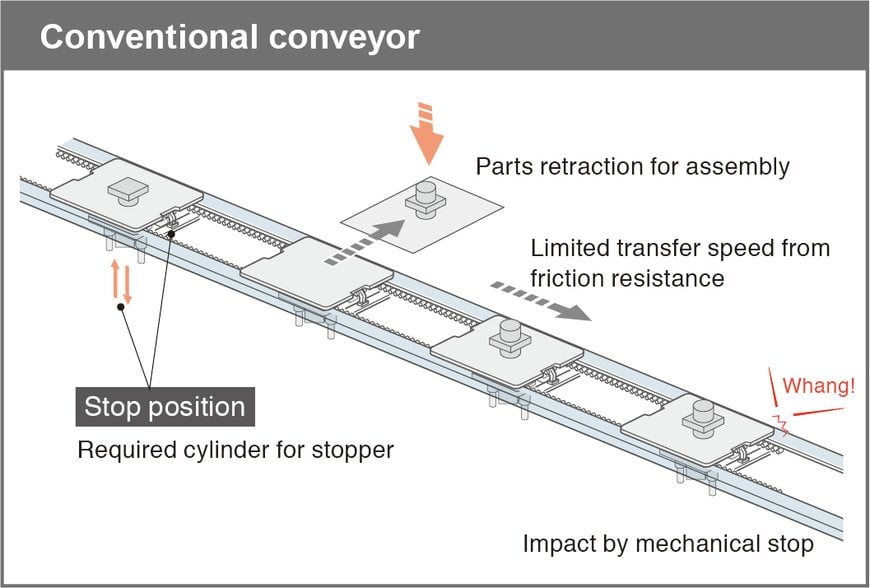
To meet today’s market demands, manufacturers need to deliver economies of scale with the agility to respond to changing market demands; by scaling production and introducing new product variants quickly. Flexibility is also needed to ensure factory floorspace and human resources are utilised efficiently, and always pursue increased productivity.
Automation is critical to achieve economies of scale. However, conventional machinery often lacks flexibility, particularly in the way workpieces are moved between machines and loaded into each one in turn to perform the prescribed sequence of manufacturing processes.
Typically, the production line may contain a combination of standard, semi-custom, and full-custom machines, linked by conveyors. Often, the conveyors must be specially designed or customised with dimensions and contours dictated by the factory floorspace. Always, the speed of any single conveyor is governed by those of others in the line, as well as the cycle time of the slowest or lengthiest processes, and buffering may be needed.
As well as restricting opportunities to individualise products on the production line, this type of automation can also be difficult to adapt; for example to accelerate production, increase production volume, or allow space on the factory floor to be reassigned.
Yamaha has helped manufacturers in diverse sectors such as automotive components, industrial electronics, and food packaging to overcome the known drawbacks of conventional automation. Four customers now share their experiences using Yamaha’s LCMR200 linear modules with SCARA and cartesian robots, after achieving advantages including faster cycle time, greater efficiency, and higher output.
Increased Productivity Per Line
An automotive components manufacturer seeking increased productivity had encountered typical barriers to improvement presented by conventional automation. The operating characteristics of mechanical stoppers and pneumatic cylinders impose lengthy carriage positioning time at each workstation. A buffer is also needed, between workstations, and the line often needed to be stopped for short periods to fix minor problems.
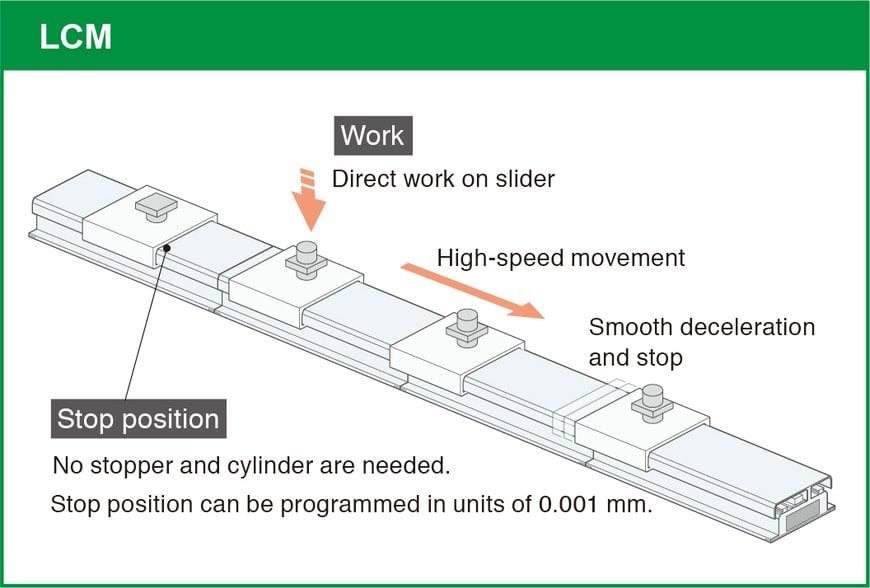
The typical options for a manufacturer in this position include increasing the number of production lines, accelerating machine operation to reduce processing time, or increasing the transfer speed between processes.
Re-engineering the production line to replace conventional conveyors with LCMR200 modules enabled the transfer time to be reduced. Moreover, the flexibility to set the transfer speed allowed buffers to be eliminated and the LCMR200 stops quickly at an accurately defined position, which significantly reduces the effective transfer time between processes. Work can be carried out directly on the LCMR200 slider, which saves process cycle time.
In this example, the transfer time was reduced from two seconds to 0.7 seconds. As a result, this customer realised a 23% increase in production volume without needing to re-engineer their assembly processes. They were also able to save the cost of the jigs needed previously to transport the workpieces on their conveyors.
Lower Changeover Workload
In another example, the manufacturer of a diverse portfolio of small electric motors has benefited from the LCMR200 to save time normally spent changing-over the line to produce the various different models. This customer had already optimised production to minimise the changeover frequency and the quantity of work involved in each setup. Opportunities for further improvement were very limited due to the time needed to adjust stopper positions and change jigs. Moreover, each new setup brings the possibility for errors to occur.
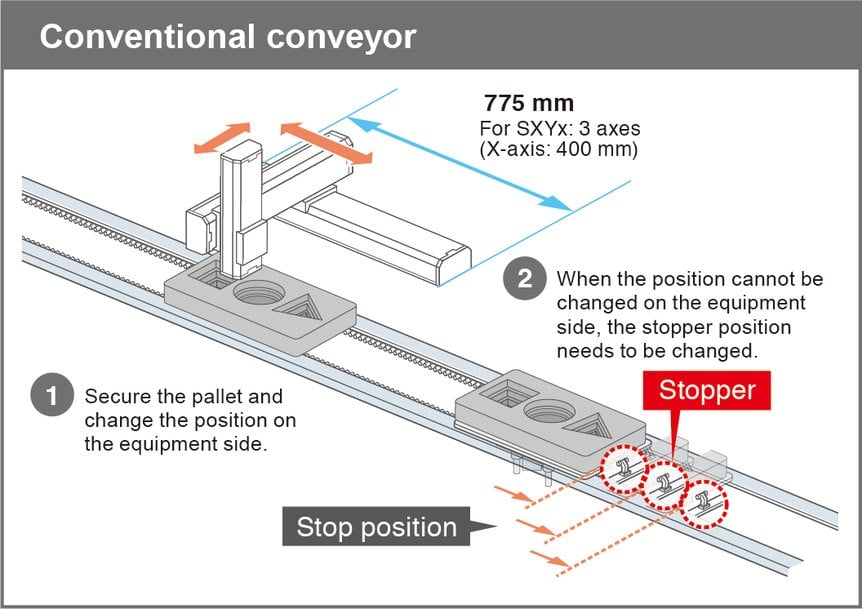
Adopting the LCMR200 modular transport reduced the setup time to almost zero by allowing stop positions to be changed by simply reprogramming, relieving any need for physical setup changes. The flexibility afforded by the new modules enabled the company to use a common jig design for all product variants, saving any need to change jigs and eliminating opportunities for inefficiency and errors. Overall, using the LCMR200 saved 16 hours of productive time normally lost every month during product changeovers.
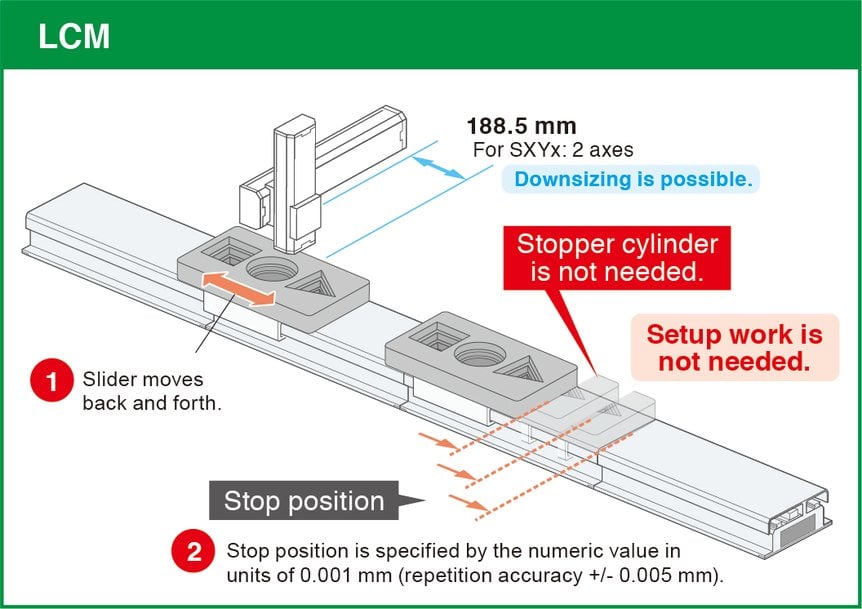
Simplified Staff Management
In a third example, in the food industry, a company packaging baked sweets used the LCMR200 to overcome the challenge of ensuring the right numbers of workers on the production line at any time. At times of peak manufacturing demand, up to eight workers can be required. Managers often struggled to secure enough workers at these times. Conversely, there were excess workers when only a small quantity of sweets were to be packed.

Using LCMR200 modules, including the innovative horizontal transfer unit, allowed one worker to deliver sweets directly from the baking process to two rows of SCARA robots used for packing the sweets into individual boxes ready to be sealed and consolidated for despatching to retailers.
This has enabled the company to overcome its staff-management challenges. Three permanently employed workers, changing over every eight hours, now maintain 24-hour production to meet the high level of market demand for the delicious baked sweets.
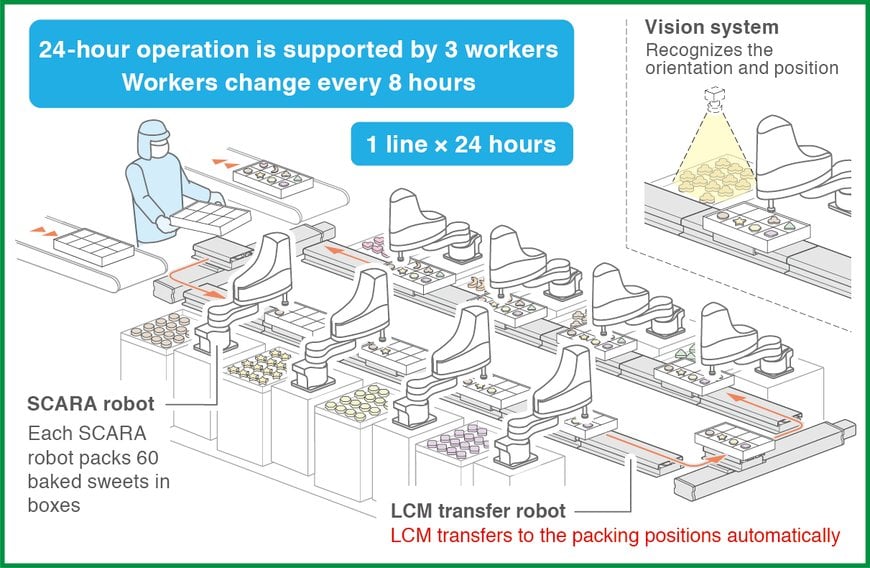
Easier Supervision and Maintenance
Finally, another company producing automotive components had been using index tables to move workpieces in a prescribed sequence between assembly robots. Index tables have several drawbacks: assembly machinery for assembly is crowded around the perimeter, which restricts access for production supervisors. Also, changing stop positions is difficult and any equipment breakdowns can cause long delays.
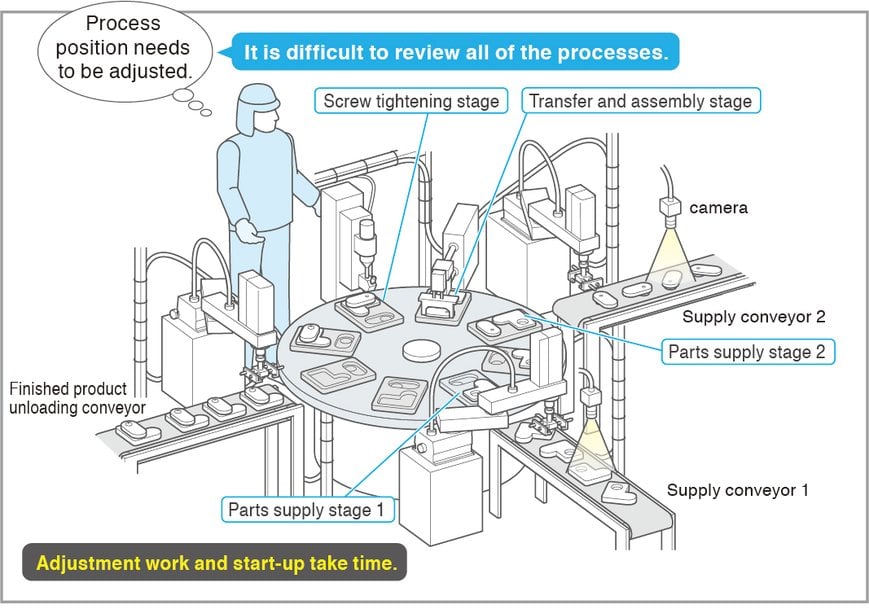
Using LCMR200 modules, including the vertical transport module, this company has implemented inline production that is more easily supervised while benefiting from high positional accuracy and precision. The LCMR200 eases fine adjustment of all stop positions.
In addition, planning and installing the line is far easier, leveraging the LCMR200’s high positional accuracy and flexibility, while its modular nature also simplifies maintenance and troubleshooting.
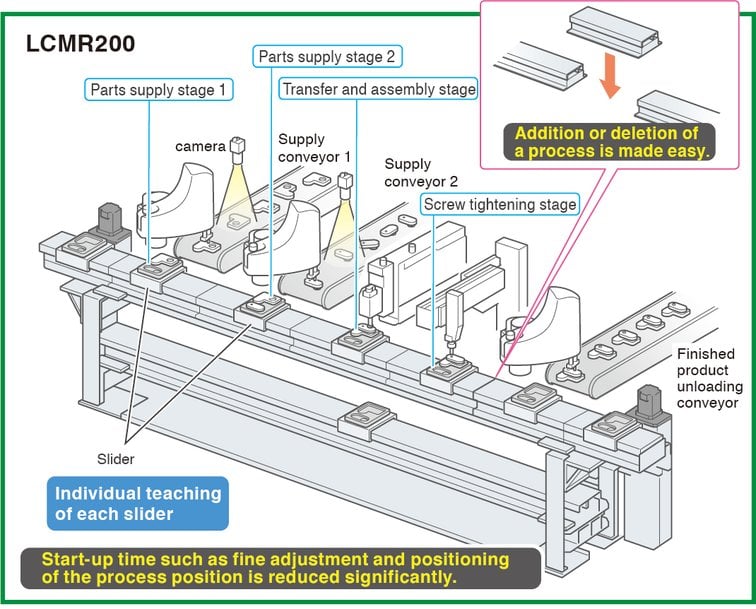
Conclusion
Manufacturing today calls for agility, to adapt to market demands and sometimes even to individual customers’ requirements. Conventional automation can be slow to implement and difficult to adapt and scale to improve productivity and raise output if needed.
A flexible solution to workpiece transport, like Yamaha's LCMR200, provides the foundation for automation that can be implemented more quickly, reconfigured more easily, and scaled more readily. Programming the modules using the same graphical software tool as other robots in the production line adds further to these advantages, easing design and configuration.
www.yamaha-motor-robotics.com
Automation is critical to achieve economies of scale. However, conventional machinery often lacks flexibility, particularly in the way workpieces are moved between machines and loaded into each one in turn to perform the prescribed sequence of manufacturing processes.
Typically, the production line may contain a combination of standard, semi-custom, and full-custom machines, linked by conveyors. Often, the conveyors must be specially designed or customised with dimensions and contours dictated by the factory floorspace. Always, the speed of any single conveyor is governed by those of others in the line, as well as the cycle time of the slowest or lengthiest processes, and buffering may be needed.
As well as restricting opportunities to individualise products on the production line, this type of automation can also be difficult to adapt; for example to accelerate production, increase production volume, or allow space on the factory floor to be reassigned.
Yamaha has helped manufacturers in diverse sectors such as automotive components, industrial electronics, and food packaging to overcome the known drawbacks of conventional automation. Four customers now share their experiences using Yamaha’s LCMR200 linear modules with SCARA and cartesian robots, after achieving advantages including faster cycle time, greater efficiency, and higher output.
Increased Productivity Per Line
An automotive components manufacturer seeking increased productivity had encountered typical barriers to improvement presented by conventional automation. The operating characteristics of mechanical stoppers and pneumatic cylinders impose lengthy carriage positioning time at each workstation. A buffer is also needed, between workstations, and the line often needed to be stopped for short periods to fix minor problems.

The typical options for a manufacturer in this position include increasing the number of production lines, accelerating machine operation to reduce processing time, or increasing the transfer speed between processes.
Re-engineering the production line to replace conventional conveyors with LCMR200 modules enabled the transfer time to be reduced. Moreover, the flexibility to set the transfer speed allowed buffers to be eliminated and the LCMR200 stops quickly at an accurately defined position, which significantly reduces the effective transfer time between processes. Work can be carried out directly on the LCMR200 slider, which saves process cycle time.
In this example, the transfer time was reduced from two seconds to 0.7 seconds. As a result, this customer realised a 23% increase in production volume without needing to re-engineer their assembly processes. They were also able to save the cost of the jigs needed previously to transport the workpieces on their conveyors.
Lower Changeover Workload
In another example, the manufacturer of a diverse portfolio of small electric motors has benefited from the LCMR200 to save time normally spent changing-over the line to produce the various different models. This customer had already optimised production to minimise the changeover frequency and the quantity of work involved in each setup. Opportunities for further improvement were very limited due to the time needed to adjust stopper positions and change jigs. Moreover, each new setup brings the possibility for errors to occur.

Adopting the LCMR200 modular transport reduced the setup time to almost zero by allowing stop positions to be changed by simply reprogramming, relieving any need for physical setup changes. The flexibility afforded by the new modules enabled the company to use a common jig design for all product variants, saving any need to change jigs and eliminating opportunities for inefficiency and errors. Overall, using the LCMR200 saved 16 hours of productive time normally lost every month during product changeovers.

Simplified Staff Management
In a third example, in the food industry, a company packaging baked sweets used the LCMR200 to overcome the challenge of ensuring the right numbers of workers on the production line at any time. At times of peak manufacturing demand, up to eight workers can be required. Managers often struggled to secure enough workers at these times. Conversely, there were excess workers when only a small quantity of sweets were to be packed.

Using LCMR200 modules, including the innovative horizontal transfer unit, allowed one worker to deliver sweets directly from the baking process to two rows of SCARA robots used for packing the sweets into individual boxes ready to be sealed and consolidated for despatching to retailers.
This has enabled the company to overcome its staff-management challenges. Three permanently employed workers, changing over every eight hours, now maintain 24-hour production to meet the high level of market demand for the delicious baked sweets.

Easier Supervision and Maintenance
Finally, another company producing automotive components had been using index tables to move workpieces in a prescribed sequence between assembly robots. Index tables have several drawbacks: assembly machinery for assembly is crowded around the perimeter, which restricts access for production supervisors. Also, changing stop positions is difficult and any equipment breakdowns can cause long delays.

Using LCMR200 modules, including the vertical transport module, this company has implemented inline production that is more easily supervised while benefiting from high positional accuracy and precision. The LCMR200 eases fine adjustment of all stop positions.
In addition, planning and installing the line is far easier, leveraging the LCMR200’s high positional accuracy and flexibility, while its modular nature also simplifies maintenance and troubleshooting.

Conclusion
Manufacturing today calls for agility, to adapt to market demands and sometimes even to individual customers’ requirements. Conventional automation can be slow to implement and difficult to adapt and scale to improve productivity and raise output if needed.
A flexible solution to workpiece transport, like Yamaha's LCMR200, provides the foundation for automation that can be implemented more quickly, reconfigured more easily, and scaled more readily. Programming the modules using the same graphical software tool as other robots in the production line adds further to these advantages, easing design and configuration.
www.yamaha-motor-robotics.com

